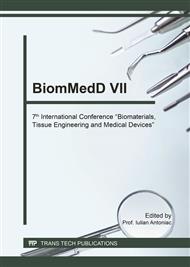[1]
N. Nakabayashi, M. Nakamura, N. Yasuda, Hybrid layer as a dentin-bonding mechanism. J. Aesthetic Rest. Dent. 3 (1991) 133-138.
DOI: 10.1111/j.1708-8240.1991.tb00985.x
Google Scholar
[2]
H. Sano, M. Yoshiyama, S. Ebisu, M.F. Burrow, T. Takatsu, B. Ciucchi, R. Carvalho, D.H. Pashley, Comparative SEM and TEM observation of nanoleakage within the hybrid layers, Oper. Dent. 20(4) (1995) 160-164.
Google Scholar
[3]
J. Sun, E. J. Petersen, S. S. Watson, C. M. Sims, A. Kassman, S. Frukhtbeyn, D. Skrtic, M. T. Ok, D. S. Jacobs, V. Reipa, Q. Ye, B. C. Nelson, Biophysical characterization of functionalized titania nanoparticles and their application in dental adhesives, Acta Biomaterialia, 53 (2017).
DOI: 10.1016/j.actbio.2017.01.084
Google Scholar
[4]
D. Prodan, A. Molea, M. Moldovan, V. Popescu, L. Silaghi-Dumitrescu, C. Prejmerean, S. Boboia, C. Sarosi, Synthesis and characterization of the hydroxyapatite and TiO2 doped hydroxyapatite powders, JOAM 16(11-12) (2014) 1300 - 1305.
DOI: 10.4028/www.scientific.net/kem.587.43
Google Scholar
[5]
M.C. Cagidiaco, M. Ferrari, A. Vichi, Mapping of tubule and intertubule surface areas available for bonding in Class V and Class II preparations, J. Dent. 25 (1997) 379-389.
DOI: 10.1016/s0300-5712(96)00060-7
Google Scholar
[6]
B. Haller, N. Hofmann, B. Klaiber, U. Bloching, Effect of storage media on microleakage of five dentin bonding agents, Dent Mater. 9(3) (1993) 191-197.
DOI: 10.1016/0109-5641(93)90119-b
Google Scholar
[7]
A. Albaladejo, R. Osorio, M. Toledano, M. Ferrari, Hybrid layers of etch- and- rinse versus self-etching adhesive systems, Med. Oral. Patol. Oral. Cir. Bucal. 15(1) (2010) 112-118.
DOI: 10.4317/medoral.15.e112
Google Scholar
[8]
S. Kenshima, C. Francci, A. Reis, A.D. Loguercio, L.E.R. Filho, Conditioning effect on dentin, resin tags and hybrid layer of different acidity self-etch adhesives applied to thick and thin smear layer, J. Dent. 34(10) (2006) 775-83.
DOI: 10.1016/j.jdent.2006.03.001
Google Scholar
[9]
I. Watanabe, N. Nakabayashi, D.H. Pashley, Bonding to ground dentin by Phenyl-P self-etching primer, J. Dent. Res. 73 (1994) 1212-1220.
DOI: 10.1177/00220345940730061301
Google Scholar
[10]
J.O.A.P. Cal-Neto, M.S. Miranda, K.R.H.C. Dias, Comparative SEM evaluation of penetration of adhesive systems in human dentin with a non rinse conditioner and a self-etching primer, Brazil. Dent. J. 15 (2004) 19-25.
DOI: 10.1590/s0103-64402004000100004
Google Scholar
[11]
J. Kim, S. Mai, F.R. Tay, All in one adhesive does not etch beyond hybrid layers, J. Dent. Research. 89(5) (2010) 482-487.
DOI: 10.1177/0022034510363665
Google Scholar
[12]
L. Tjaderhane, F.D. Nascimento, L. Breschi, A. Mazzoni, I.L.S. Tersariol, S. Geraldeli, A.T. Mutluay, M. Arrilho, R.M. Carvalho, F.R. Tay, D.H. Pashley, Strategies to prevent hydrolytic degradation of the hybrid layer-A review, Dent. Mat. 29 (10) (2013).
DOI: 10.1016/j.dental.2013.07.016
Google Scholar
[13]
U. Lohbauer, S.A. Nikolaenko, A. Petschelt, R. Frankenberg, Resin tags do not contribute to dentin adhesion in self-etching adhesives, J. Adhesive Dent. 10 (2008) 97-103.
Google Scholar
[14]
R.H. Sunfeld, C.H. Oliviera, A. Silva, A.L. Briso, M.L. Sundefeld, Resin tag length of one step and self etching adhesives bonded to unground enamel, Bull. Tokyo. Dent. Coll. 46(3) (2005) 43-49.
DOI: 10.2209/tdcpublication.46.43
Google Scholar
[15]
E. Eliguzeloglu, H. Omurlu, G. Eskitascioglu, S. Belli, Effect of surface treatments and different adhesives on the hybrid layer thickness of on carious cervical lesions. Oper. Dent. 33(3) (2008) 338- 345.
DOI: 10.2341/07-96
Google Scholar


